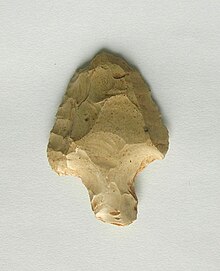
Back ثقافة عاترية Arabic Aterià Catalan Atérien German Ateriense Spanish Aterin kulttuuri Finnish Atérien French Cultura ateriana Italian アテル文化 Japanese ატერიის კულტურა Georgian Atiro kultūra Lithuanian
 Aterian point from Zaccar, Djelfa region, Algeria | |
| Geographical range | North Africa, Sahara, Northeast Africa, Arabia?, Oman?, Thar Desert? |
|---|---|
| Period | Middle Palaeolithic – Upper Palaeolithic |
| Dates | c. 150,000 – c. 20,000 BP[1] |
| Type site | Bir el Ater |
| Major sites | Taforalt, Ifri n'Ammar, Kharga Oasis, Dar es Soltan I & II, Grotte des Contrebandiers, Mugharet el Aliya, Uan Tabu, Adrar Bous, Bir Tarfawi |
| Preceded by | Mousterian |
| Followed by | Emiran, Ahmarian, Khormusan, Iberomaurusian |

The Aterian is a Middle Stone Age (or Middle Palaeolithic) stone tool industry centered in North Africa, from Mauritania to Egypt, but also possibly found in Oman and the Thar Desert.[2][3] The earliest Aterian dates to c. 150,000 years ago, at the site of Ifri n'Ammar in Morocco.[4] However, most of the early dates cluster around the beginning of the Last Interglacial, around 150,000 to 130,000 years ago, when the environment of North Africa began to ameliorate.[5] The Aterian disappeared around 20,000 years ago.
The Aterian is primarily distinguished through the presence of tanged or pedunculated tools,[6] and is named after the type site of Bir el Ater, south of Tébessa.[7] Bifacially-worked, leaf-shaped tools are also a common artefact type in Aterian assemblages, and so are racloirs and Levallois flakes and cores. Items of personal adornment (pierced and ochred Nassarius shell beads) are known from at least one Aterian site, with an age of 82,000 years.[8] The Aterian is one of the oldest examples of regional technological diversification, evidencing significant differentiation to older stone tool industries in the area, frequently described as Mousterian. The appropriateness of the term Mousterian is contested in a North African context, however.
- ^ Hardesty, Donald L. (2010-06-15). ARCHAEOLOGY – Volume II. EOLSS Publications. p. 38. ISBN 9781848260030.
- ^ Vermeersch, Pierre (2000). "The Nubian Complex and the Dispersal of Modern Humans in North Africa". In Krzyżaniak, Lech; Kroeper, Karla; Kobusiewicz, Michał (eds.). Recent Research into the Stone Age of Northeastern Africa. ISBN 83-907529-6-4 – via ResearchGate.
- ^ Cite error: The named reference
Schugwas invoked but never defined (see the help page). - ^ Richter, Daniel; Moser, Johannes; Nami, Mustapha; Eiwanger, Josef; Mikdad, Abdeslam (2010-12-01). "New chronometric data from Ifri n'Ammar (Morocco) and the chronostratigraphy of the Middle Palaeolithic in the Western Maghreb". Journal of Human Evolution. 59 (6): 672–679. doi:10.1016/j.jhevol.2010.07.024. PMID 20880568.
- ^ "Stone Tools Suggest Modern Humans Lingered in Arabia - Archaeology Magazine".
- ^ Scerri, Eleanor M. L. (2013-06-25). "The Aterian and its place in the North African Middle Stone Age" (PDF). Quaternary International. The Middle Palaeolithic in the Desert. 300: 111–130. Bibcode:2013QuInt.300..111S. doi:10.1016/j.quaint.2012.09.008.
- ^ Langer, William L., ed. (1972). An Encyclopedia of World History (5th ed.). Boston, MA: Houghton Mifflin Company. pp. 9. ISBN 978-0-395-13592-1.
- ^ Bouzouggar, Abdeljalil; Barton, Nick; Vanhaeren, Marian; d'Errico, Francesco; Collcutt, Simon; Higham, Tom; Hodge, Edward; Parfitt, Simon; Rhodes, Edward (2007-06-12). "82,000-year-old shell beads from North Africa and implications for the origins of modern human behavior". Proceedings of the National Academy of Sciences. 104 (24): 9964–9969. doi:10.1073/pnas.0703877104. ISSN 0027-8424. PMC 1891266. PMID 17548808.